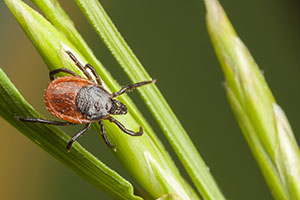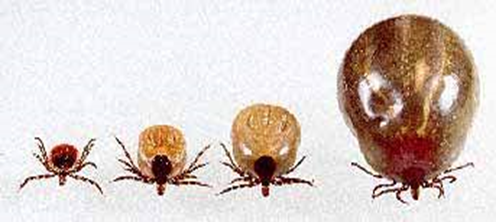
Lyme Disease Primer for Pediatric Providers
 Peter Wenger, MD
Peter Wenger, MD
Attending Physician, Infectious Diseases, Departments of Pediatrics
Children’s Hospital of New Jersey at Newark Beth Israel Medical Center
Cooperman Barnabas Medical Center
 We are entering the season local physicians are most likely to encounter patients with Lyme disease. The majority of early localized and early disseminated Lyme disease occur between April and October with over 50% of cases in June and July. The geographic distribution of the disease follows the distribution of its tick vector, Ixodes scapularis (aka blacklegged or deer tick) in the eastern US (New England and the Mid-Atlantic states including NJ as far south as Virginia) and the upper Midwest (Wisconsin and Minnesota) and Ixodes pacificus in the West (most commonly northern California). Over 90% of cases in the US are reported from the eastern US with the highest incidence rates in children 5 through 9 years of age and adults 55 through 59 years of age. The only way a person can get Lyme disease is by being bitten and fed upon by the appropriate tick vector that is carrying the Lyme spirochete, Borrelia burgdorferi at the time it is feeding. The Lyme agent takes its time migrating from tick vector to human so the tick must be feeding on the host for at least 36 to 48 hours for transmission to occur. The overall risk of transmission from an observed tick bite (note not all ticks in any given area belong to the Ixodes species) even in highly endemic areas is low (no higher than 3%). After removal of an engorged Ixodes scapularis tick that has been in feeding (that is imbedded) for > 72 hours the risk of transmission in highly endemic areas may be 25%. A recently described species, Borrelia mayonii, has been identified in a small number of patients in the upper Midwest with a similar clinical presentation as seen with Lyme disease however it is diagnosed and treated as Lyme due to B. burgdorferi. Vertical transmission from mother to fetus is not thought to occur and pregnancy or congenital consequences due to maternal Lyme infection have not been documented. There is no evidence the agent of Lyme is transmitted via breast milk.
We are entering the season local physicians are most likely to encounter patients with Lyme disease. The majority of early localized and early disseminated Lyme disease occur between April and October with over 50% of cases in June and July. The geographic distribution of the disease follows the distribution of its tick vector, Ixodes scapularis (aka blacklegged or deer tick) in the eastern US (New England and the Mid-Atlantic states including NJ as far south as Virginia) and the upper Midwest (Wisconsin and Minnesota) and Ixodes pacificus in the West (most commonly northern California). Over 90% of cases in the US are reported from the eastern US with the highest incidence rates in children 5 through 9 years of age and adults 55 through 59 years of age. The only way a person can get Lyme disease is by being bitten and fed upon by the appropriate tick vector that is carrying the Lyme spirochete, Borrelia burgdorferi at the time it is feeding. The Lyme agent takes its time migrating from tick vector to human so the tick must be feeding on the host for at least 36 to 48 hours for transmission to occur. The overall risk of transmission from an observed tick bite (note not all ticks in any given area belong to the Ixodes species) even in highly endemic areas is low (no higher than 3%). After removal of an engorged Ixodes scapularis tick that has been in feeding (that is imbedded) for > 72 hours the risk of transmission in highly endemic areas may be 25%. A recently described species, Borrelia mayonii, has been identified in a small number of patients in the upper Midwest with a similar clinical presentation as seen with Lyme disease however it is diagnosed and treated as Lyme due to B. burgdorferi. Vertical transmission from mother to fetus is not thought to occur and pregnancy or congenital consequences due to maternal Lyme infection have not been documented. There is no evidence the agent of Lyme is transmitted via breast milk.
The I. scapularis tick can also harbor Borrelia miyamotoi and the agents responsible for babesiosis and anaplasmosis and patients with early Lyme may be simultaneously infected with these agents. These diagnoses should be suspected in in patients who present with high fever or hematologic abnormalities or do not respond as expected to therapy for Lyme. In addition, patients with Lyme disease may be co-infected with Powassan virus (deer tick virus).
Clinical Presentation
The clinical presentation of Lyme disease is divided into 3 stages: early localized, early disseminated, and late Lyme disease. Early localized Lyme is characterized by a distinctive cutaneous lesion, erythema migrans, which appears 3 to 32 days from the infected tick bite with a median time of 11 days. It appears at the site of the tick bite, initially as a red macule or papule which expands over the next several days to weeks to a large (> 5 cm in diameter) annular, erythematous lesion, occasionally with partial central clearing (bulls-eye lesion) that is usually non-pruritic and non-painful. While this is the most common clinical manifestation of Lyme in children it is not always present. Fever, if present, is generally mild and erythema migrans may be accompanied by malaise, headache, mild neck stiffness, myalgia and arthralgia. Early disseminated Lyme is characterized by multiple erythema migrans lesions appearing several weeks after the tick bite that are similar but usually smaller than the primary lesion. Other characteristic manifestations, with or without the skin lesions, include palsies of the cranial nerves (most commonly the VII nerve), lymphocytic meningitis (often associated with cranial neuropathy or papilledema), radiculitis, and carditis, which usually presents as varying degrees of heart block. Carditis is not often seen in children but is found most commonly in young adult men and can be life threatening. Non-specific systemic symptoms (mild fever, arthralgia, malaise, headache, and fatigue) can accompany the characteristic symptomatology described in early disseminated Lyme. Late Lyme disease occurs in patients who were not treated at earlier stages and may not be preceded by a history consistent with earlier stages of the disease. In children it most commonly presents as an inflammatory arthritis. It is usually mono- or pauciarticular in nature and affects the large joints, usually the knees. It usually presents with joint swelling/effusion out of proportion with pain or disability. I once saw a young man with a subsequent diagnosis of Lyme arthritis who initially presented with significant knee swelling which did not prevent him from running on the long-distance track team in high school. This clinical presentation along with a lesser elevation of peripheral neutrophils and ESR help distinguish Lyme arthritis from a septic joint. Polyneuropathy, encephalopathy, and encephalopathy while they may be present are very rare.
It is critical to note that non-specific constitutional symptoms (e.g., fever, malaise, arthralgia, myalgia, and headache) often accompany the characteristic signs seen in all 3 stages of Lyme, however are almost never the only evidence of Lyme disease. Patients with Lyme disease almost always present with the characteristic signs of Lyme as described above.
Diagnosis
It follows then that serologic testing for Lyme disease should not be performed in patients who do not present with the characteristic signs and symptoms described for Lyme disease and history of plausible geographic exposure. The standard testing method for Lyme disease in clinical practice at this time is a 2-tier serologic algorithm. The first test is qualitative in nature (results reported as positive, negative, or equivocal) and is performed using an enzyme-linked immunosorbent assay (ELISA or EIA) or immunofluorescent antibody (IFA) test. Depending on what commercial lab used you may find this test reported as “Lyme ELISA”, “Lyme antibody screen”, “total Lyme antibody”, or “Lyme IgG/IgM”. If negative the patient is considered seronegative and no further testing is required. If positive or equivocal the 2nd tier test will be performed which increases overall test specificity. The test used is the standardized Western immunoblot (Western blot) which identifies the presence of antibodies directed against specific B. burgdorferi antigens including IgM to 3 antigens and IgG to 10 antigens. A positive Western blot result is defined as the presence of antibodies to at least 2 IgM antigens (bands) or 5 IgG bands. Some labs will report the results of all IgM and IgG bands and most people will test positive for at least one band however the study is considered negative for Lyme unless the above criteria are met.
There are several caveats to keep in mind when considering serologic studies for Lyme diagnosis. Serologic studies are not required In patients with erythema migrans and a history of plausible geographic exposure. It’s likely too early in the course of infection for most of these patients to have mounted a serological immune response and studies are likely to produce false negative results. In fact, patients treated appropriately during the early localized stage of the disease may never develop detectable antibodies to B. burgdorferi and are considered cured and not at risk of developing later manifestations of disease. A clinical diagnosis is sufficient and appropriate treatment should be initiated (see below). Do not send stand-alone Western blot studies for Lyme diagnosis as the specificity of the diagnostic 2-tier test algorithm suffers without the initial qualitative test. Almost all patients with early disseminated and late Lyme disease will have mounted an IgG immune response by 30 days after symptom onset therefore the IgM Western blot results are not useful after that date. They may be automatically done as part of a labs 2-tier test algorithm however it is the IgG result that will determine the diagnosis in patients who report characteristic Lyme signs and symptoms. Once a patient has mounted an immune serologic response the IgG antibodies are long-lived therefore follow-up serologic studies to gauge treatment response are unwarranted.
Do not send CSF for PCR studies with suspected neuroborreliosis as the yield of this study is too low to be useful in establishing the diagnosis. A PCR study of joint fluid for those with suspected Lyme arthritis can be of assistance in making that diagnosis while the usefulness of a PCR assay on blood has not been established to date and is therefore not recommended.
Treatment
Early Localized Disease
Erythema migrans (single or multiple) (any age)
Doxycycline 4.4 mg/kg/day , orally, divided in 2 doses (max 200 mg/day) for 10 days
OR
Amoxicillin, 50 mg/kg/day, orally, divided into 3 doses (max 1.5 g/day) for 14 days
OR
Cefuroxime, 30 mg/kg/day, orally, divided in 2 doses (max 1 g/day) for 14 days
OR
For those unable to take doxycycline or a beta-lactam, Azithromycin, 10 mg/kg/day, orally, once daily for 7 days.
Extracutaneous Disease
Isolated Facial Palsy
Doxycycline, 4.4 mg/kg/day, orally, divided into 2 doses (max 200 mg/day) for 14 days.
Corticosteroids should not be used.
There is insufficient evidence for the use of amoxicillin in children with facial palsy.
Treatment has no effect on the resolution of facial nerve palsy. Its purpose is to prevent late disease.
Arthritis
An oral agent recommended for early localized disease as above however for 28 days.
As there are only limited safety data on the use of doxycycline for >21 days in children <8 years of age would select amoxicillin or cefuroxime in this age cohort at this time.
Persistent arthritis after first course of therapy.
Repeat using an oral agent as recommended for a first episode arthritis for 28 days
OR
Ceftriaxone sodium, 50-75 mg/kg/day, IV, once daily (max 2g/day) for 14-28 days.
Atrioventricular Heart Block or Carditis
An oral agent as recommended for early localized disease for 14-21 days
OR
Ceftriaxone sodium, 50-75 mg/kg/day, IV, once daily (max 2g/day) 14-21 days for a hospitalized patient. Oral therapy as recommended for early localized disease can be substituted when the patient has stabilized or is discharged home to complete the 14-21 day course.
Meningitis
Doxycycline 4.4 mg/kg/day, orally, divided into 2 doses (max 200 mg/day) for 14 days
As an alternative to patients with meningitis who are well enough to be treated without hospitalization
OR
Ceftriaxone sodium, 50-75 mg/kg/day, IV, once daily (max 2g/day) for 14 days.
Persistent Post-Treatment Lyme Disease Syndrome
This condition is commonly mistakenly called chronic Lyme disease. Generally, these mostly adult patients complain of subjective symptoms such as headache, musculoskeletal pain, arthralgia, lethargy, cognitive complaints, and/or fatigue that may persist for months after appropriate treatment. These patients deserve a careful evaluation for any signs and symptoms characteristic of active Lyme (see above) and if present retreatment may be necessary. You may want to consult with an infectious disease specialist in this instance. However multiple studies have not demonstrated active B. burgdorferi infection with this syndrome and the use of additional antimicrobial therapy is discouraged.
There is a post-infectious persistent, inflammatory proliferative synovitis that may persist for months or even years after appropriate antimicrobial therapy. Again, this is found more commonly in adults then children. This complication results from an excessive, deregulated immune response during the acute infection which persists in the post-infectious period and is seen in other forms of chronic inflammatory arthritis including rheumatoid arthritis.
Prevention

- Reduce exposure to ticks
- Hike in the center of trails
- Ticks require humidity to survive thus drier areas are less infested
- Locate backyard play equipment away from forest edges
- Create a barrier of dry wood chips or gravel between recreation areas and wooded areas
- Regular mowing of grass and trimming of shrubs and bushes
- Keep leaves raked and underbrush cleared
- Wear appropriate clothing
- Clothing should cover arms, legs, head. and other exposed skin areas
- Tuck in shirts, pants into socks, and wearing closed shoes instead of sandals when in potential tick-infected areas
- Consider permethrin 0.5% treatment of clothing and gear
- Do not spray permethrin directly on skin
- Treated clothing should be dried prior to wearing
- EPA-approved commercial permethrin-treated outdoor clothing, hats, bed nets, and camping gear safe for children and pregnant women are available.
- Permethrin should not be used on clothing or netting where children may chew or suck
- Only EPA-approved skin repellents should be used
- Follow directions according to the label
- Tick inspection and removal
- Parents or caregivers should inspect, in a timely manner, themselves and their children’s bodies, clothing, and equipment after every potential tick exposure
- Removing ticks as quickly as possible is crucial for blocking B. burgdorferi transmission
- When removing an embedded tick, grasp the tick close to the skin using a fine-tipped forceps or tweezers and gently pull straight out without twisting motions. Be careful not to break off mouth parts when removing the tick. The tweezers should then be cleaned after removal of the tick prior to using for removal of any residual mouth parts left on the skin. Cutting or digging into the skin to remove small remnants in the skin should be avoided. If fingers are used they should be protected by plastic gloves or a tissue and washed immediately after tick removal. Clean the bite site with soap and water immediately after tick removal to prevent secondary skin infection.
- Bathing or showering within 2 hours after coming indoors has been shown as effective in preventing tickborne diseases
- Placing clothing in a dryer on high heat (10 minutes for dry clothes, up to 1 hour for damp clothing) can be effective in killing unattached ticks on clothing
- Maintaining tick-free pets will decrease tick exposure. Daily inspection of pets for ticks and routine use of appropriate veterinary products is important.
Chemoprophylaxis
In areas of high endemicity a single dose of oral doxycycline, 4.4 mg/kg (max dose 200 mg) can be used in any child after a bite of an infected I. scapularis tick 72 hours after tick removal. When considering prophylaxis note the risk of infection is increased if the tick is engorged (indicating feeding for at least 36 hours) and extremely low if the tick is nonengorged and flat (see Figure 1). Of course, there is no risk of transmission if the tick is not Ixodes scapclaris. Do not send the tick to test for B.burgdorferi infection as it has poor predictive value and is not recommended.

Figure 1. Various states of engorgement of Ixodes scapularis tick